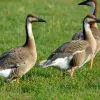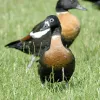
Mexican duck (Anas platyrchynchos diazi)
Species name
- Dutch name:
- Mexicaanse eend
- English name:
- Mexican duck
- German name:
- Mexikoente
- French name:
- Canard du Mexique
- Scientific name:
- Anas platyrchynchos diazi
Scientific classification
- Order:
- Anseriformes
- Family:
- Anatidae
- Onderfamilie:
- Anatinae
- Genus:
- Anas
Description
- Description:
Male:
Head light brown with a Dark brown to black eyestripe. Body plumage darker and richer in color, especially on breast, which rich reddish brown; feathers on breast and underparts with large dark brown to blackish areas in the centers, with tendency for these to be aligned in broad streaks. Belly, vent and undertail-converts darker, with end of tail coverts almost black. Tail all dark or, on a few individuals, paling to whitish at the edges. Feathers on mantle U-shaped and darker markings internally and pale edgings, while on longer scapulars marks are elongated and V- shaped. Upper wing is dark, and Speculam vivid green, less blue. White bar at front more buff. Bill olive to banana yellow; no black spot at base of upper mandible. Feet and legs deep orange.Female:
Light Brown molding threw out body lacking reddish hue in feathers. Bar in front of white Speculam tawny buff. Bill more olive green with traces of orange at base and black on center of bill. Feet and legs deep orange.Juvenile:
Has more black strikes then adult and very finely marked on chest.
- Behaviour:
Aggressive and territorial, but small loose groups also seen and (previously) larger flocks of amore than 200 birds. Sometimes found feeding with other duck species. Long term pair bonds.
Standard Measurements
- Body Length (cm):
- The male (drake) of the Mexican duck measures approximately 63-68 centimeters. The female measures approximately 63-68 centimeters.
- Body Weight (grams):
- The male will weight about 995 gram. The female will weight about 910 gram.
The weight is notoriously variable and can only be used as indication!
- Note:
Dabbling Ducks are generally hardy, easy to maintain and easy to breed. Shelter may be required by some of the smaller species in winter. They should be provided with cover (including marginal pond cover) and loafing areas as well as water. A pen which is 50% water is suggested. The water may be shallow (i.e. no more than two feet deep is required), and muddy areas for dabbling in are also appreciated. These ducks are generally good in mixed collections, although the smaller and quieter species may be bullied. Territorial disputes between ducks of the same species may be avoided by keeping only one pair of each species in an enclosure, unless the area is very large. For a single pair of ducks a pen are of 50 to 100 square metres, depending on the size of duck, should be provided.
A diet based on wheat and pellets is suggested, with maintenance pellets changed to breeders pellets for the breeding season. Ggreenfood is also appreciated. Grit should always be available, with soluble grit (e.g. oystershell grit) as a calcium source when breeding.
Most species are ground nesters and both close ground cover and ground level nest boxes should be provided. Hand-rearing is generally preferred, as these ducks are generally poor parents in captive conditions, particularly in enclosures shared with other waterfowl. These ducks are prone to hybridization, particularly with closely related species, which should be kept apart from one another.
Meller's ducks are hardy, somewhat aggressive and not difficult to keep; the enclosure should include water, loafing areas and ground cover.
These ducks are fairly easily bred in captivity. Good close ground cover and ground-level nest boxes should be provided, and seclusion. Ducklings may be broody-incubated and reared; they are not difficult to rear, using chick crumbs, chopped hard-boiled egg, lettuce, plus mealworms and crickets to stimulate feeding.
Drakes frequently hybridise; they should be kept separate from closely-related mallard-type ducks.
- Breeding:
- The female Mexican duck usually lays from 5-10 white-tan eggs and incubates them for 28-29 days.
- Artificial incubating:
The ideal relative humidity for incubating most waterfowl eggs is 55% (ground nesters) and 40% (cavity nesters). The temperature is usually 37.4°C. Set ventilation as recommended by the incubator manufacturer. Eggs must be turned, either automatically or by hand, a minimum of 4 times a day. As the duckling develops there is a loss of water from the egg and the air sac gets bigger. In normal development of an egg with a 28-29 days incubation, the air sac occupies about a third of it three days earlier. Cleanliness is vital and ideally eggs should be moved to a separate hatcher at this point, where the humidity should be increased to 65% and even higher once they have pipped internally.
- Bird banding:
- Recommended closed leg band ring size for the Mexican duck is 11 mm.The leg band ring can only be applied on a young dabbling duck at around 11-12 days old.
- It doesn't matter what leg that you band, but it's good to have a consistent system. Suggested: Left leg = Female, Right leg = Male
- Maintenance food:
-





Lundi Regular with a protein content of 20%, valuable Spirulina and high-quality by-products is optimally balanced in its composition maintenance food for water ornamental fowl of all kinds. Especially green teal and Whistling ducks that are not dependent on a very high protein content, are well supplied.
Lundi Regular contains all the minerals and vitamins in full form that are important for the animals. Therefore also suitable as breeding food.





Floating full food for all sea ducks, green ducks, eider ducks and geese, especially in the moulting and breeding phase ideally suited. Packed with wholesome raw materials, natural vitamins and trace elements, this performance food with a protein content of 30% forms the basis for lifelong vitality.
